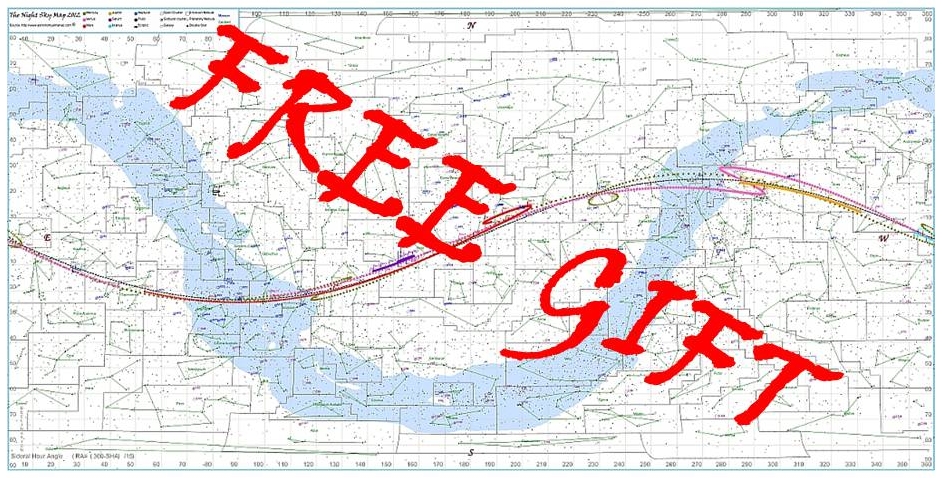The almanac structure
The hourglass almanac is a table with 96 quarter-hours as columns and 365(6) days as rows.The almanac indicates local time, WITHOUT DAYLIGHT SAVING TIME adjustment, unless otherwise stated. The time was averaged to the nearest quarter-hour for legibility. The time reference is provided at the top, in the middle and at the bottom of the table, a vertical line indicates the full hour. Day numbers are provided on the both sides of the table, color marked for spring equinox, summer solstice, fall equinox, and winter solstice.
The hourglass graphical structure of the almanac provides the most important information about our Solar System and light observing conditions. The table to the right contains additional information, which may be found useful. The almanac also displays positions of Galilean moons for the whole year. The phases and positions of the Galilean moons are indicated at midnight UT. Rise and set at local time (including Daylight Saving Time adjustment for US locations).
CLICK HERE FOR INSTRUCTIONS HOW TO PRINT & STITCH
Horizontal lines – how to use the almanac most efficiently
Knowing the date associated with each line will help you find your date of interest. There are four types of lines that will help you to orient yourself in the middle of the table:
- GREEN for first day of each month
- BLACK for new Moon
- GRAY for both first and last Moon quarters
- WHITE for full Moon.
Icons
The legend at the bottom of the almanac explains each icon’s meaning.
Available Information
UNDERLINED data are available in the table only
The Sun:
- Sunset: The moment the trailing edge of the Sun's disk disappears below the horizon.
- Sunrise: The moment the leading edge of the Sun’s disk appears above the horizon.
- Civil twilight: Morning civil twilight (civil dawn) begins when the geometric center of the sun is 6° below the horizon and ends at sunrise. Evening civil twilight (civil dusk) begins at sunset and ends when the geometric center of the sun reaches 6° below the horizon.
- Nautical twilight: Nautical twilight is the time when the center of the sun is between 6° and 12° below the horizon.
- Astronomical twilight: Astronomical twilight is the time when the center of the sun is between 12° and 18° below the horizon.
- Night
The Moon: Main Phases, set and rise time, disk illumination (midnight UT)
Planets:
- Mercury, Venus: set and rise time, phases (100 - disk size) (midnight UT)
- Mars, Jupiter, Saturn, Uranus, Neptune: transit* time, opposition** date, rise, set, altitude (at transit), magnitude
- Pluto: transit, altitude (at transit), magnitude
- Galilean moons relative positions
Meteor showers: peak (no exact time provided)
Solar and Lunar Eclipses (if visible from the location)
Transit of Venus time (if visible from the location)
*Transit occurs when a celestial body crosses the meridian due to the Earth's rotation, about halfway between rising and setting. For instance, the Sun transits the meridian at solar noon.
**A planet is said to be "in opposition" when it is in opposition to the Sun as seen from the Earth.
The almanac was created using custom Perl algorithm that mines and translates astronomical data from the United States Naval Observatory into MS Excel spreadsheet. The Galilean moons positions were calculated based on algorithm described in Sky&Telescope Magazine from June 1989.
All pictures used in the almanac are either public domain or GNU General Public Licence
This almanac is a copyrighted work; you may modify the original file as you wish, but
I ask you not to distribute it in any form without my prior knowledge and permission.






